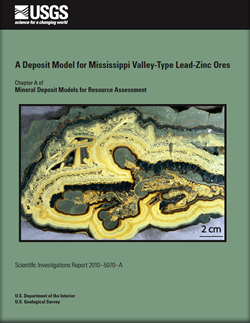Scientific Investigations Report 2010–5070-A

This report is a descriptive model of Mississippi Valley-Type (MVT) lead-zinc deposits that presents their geological, mineralogical and geochemical attributes and is part of an effort by the U.S. Geological Survey Mineral Resources Program to update existing models and develop new models that will be used for an upcoming national mineral resource assessment. This deposit modeling effort by the USGS is intended to supplement previously published models for use in mineral-resource and mineral-environmental assessments. Included in this report are geological, geophysical and geochemical assessment guides to assist in mineral resource estimation. The deposit attributes, including grade and tonnage of the deposits described in this report are based on a new mineral deposits data set of all known MVT deposits in the world. Mississippi Valley-Type (MVT) lead-zinc deposits are found throughout the world but the largest, and more intensely researched deposits occur in North America. The ores consist mainly of sphalerite, galena, and generally lesser amounts of iron sulfides. Silver is commonly an important commodity, whereas Cu is generally low, but is economically important in some deposits. Gangue minerals may include carbonates (dolomite, siderite, ankerite, calcite), and typically minor barite. Silicification of the host rocks (or quartz gangue) is generally minor, but may be abundant in a few deposits. The deposits have a broad range of relationships with their host rocks that includes stratabound, and discordant ores; in some deposits, stratiform and vein ore are important. The most important characteristics of MVT ore deposits are that they are hosted mainly by dolostone and limestone in platform carbonate sequences and usually located at flanks of basins, orogenic forelands, or foreland thrust belts inboard of the clastic rock-dominated passive margin sequences. They have no spatial or temporal relation to igneous rocks, which distinguishes them from skarn or other intrusive rock-related Pb-Zn ores. Abundant evidence has shown that the ore fluids were derived mainly from evaporated seawater and were driven within platform carbonates by large-scale tectonic events. MVT deposits formed mainly during the Phanerozoic with more than 80 percent of the deposits hosted in Phanerozoic rocks and less than 20 percent in Precambrian rocks. Phanerozoic-hosted MVT deposits also account for 94 percent of total MVT ore, and 93 percent of total MVT lead and zinc metal. Many MVT deposits formed during Devonian to Permian time, corresponding to a series of intense tectonic events during assimilation of Pangea. The second most important period for MVT deposit genesis was Cretaceous to Tertiary time when microplate assimilation affected the western margin of North America and Africa-Eurasia. Many subtypes or alternative classifications have been applied to MVT deposits. These alternative classifications reflect geographic and or specific geological features that some workers believe set them apart as unique (for example, Appalachian-, Alpine-, Reocin-, Irish-, Viburnum trend-types). However, we do not consider these alternative classifications or sub-types to be sufficiently different to warrant using them. This report also describes the geoenvironmental characteristic of MVT deposits. The response of MVT ores in the supergene environment is buffered by their placement in carbonate host rocks which commonly results in near-neutral associated drainage water. The geoenvironmental features and anthropogenic mining effects presented in this report illustrates this important environmental aspect of MVT deposits which separates them from other deposit types (especially coal, VHMS, Cu-porphyry, SEDEX, acid-sulfate polymetallic vein). |
First posted July 29, 2010 For additional information contact: Part or all of this report is presented in Portable Document Format (PDF); the latest version of Adobe Reader or similar software is required to view it. Download the latest version of Adobe Reader, free of charge. |
Leach, D.L., Taylor, R.D., Fey, D.L., Diehl, S.F., and Saltus, R.W., 2010, A deposit model for Mississippi Valley-Type lead-zinc ores, chap. A of Mineral deposit models for resource assessment: U.S. Geological Survey Scientific Investigations Report 2010–5070–A, 52 p.
Abstract
Introduction
Deposit Type and Associated Commodities
Historical Evolution of Descriptive and Genetic Knowledge and Concepts
Regional Environment
Physical Description of Deposits
Use of Geophysics in Resource Assessment for Mississippi Valley-Type Deposits
Hypogene Ore Characteristics
Hypogene Gangue Characteristics
Hydrothermal Alteration
Supergene Ore and Gangue Characteristics
Weathering/Supergene Processes
Geochemical Characteristics
Theory of Deposit Formation
Geological Assessment Guides
Geoenvironmental Features and Anthropogenic Mining Effects
Acknowledgments
References
Appendix